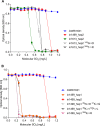Brettanomyces bruxellensis SSU1 Haplotypes Confer Different Levels of Sulfite Tolerance When Expressed in a Saccharomyces cerevisiae SSU1 Null Mutant
- PMID: 30552183
- PMCID: PMC6365814
- DOI: 10.1128/AEM.02429-18
Brettanomyces bruxellensis SSU1 Haplotypes Confer Different Levels of Sulfite Tolerance When Expressed in a Saccharomyces cerevisiae SSU1 Null Mutant
Abstract
The addition of SO2 is practiced in the wine industry to mitigate the risk of microbial spoilage and to extend wine shelf-life. Generally, this strategy does not interfere with primary alcoholic fermentation, as wine strains of Saccharomyces cerevisiae exhibit significant SO2 tolerance, largely driven by the efflux pump Ssu1p. One of the key yeast species responsible for wine spoilage is Brettanomyces bruxellensis, which also exhibits strain-dependent SO2 tolerance, although this occurs via unknown mechanisms. To evaluate the factors responsible for the differential sulfite tolerance observed in B. bruxellensis strains, we employed a multifaceted approach to examine both expression and allelic differences in the BbSSU1 gene. Transcriptomic analysis following exposure to SO2 highlighted different inducible responses in two B. bruxellensis strains. It also revealed disproportionate transcription of one putative BbSSU1 haplotype in both genetic backgrounds. Here, we confirm the functionality of BbSSU1 by complementation of a null mutant in a S. cerevisiae wine strain. The expression of four distinct BbSSU1 haplotypes in the S. cerevisiae ΔSSU1 mutant revealed up to a 3-fold difference in conferred SO2 tolerance. Substitution of key amino acids distinguishing the encoded proteins was performed to evaluate their relative contribution to SO2 tolerance. Protein modeling of two haplotypes which differed in two amino acid residues suggested that these substitutions affect the binding of Ssu1p ligands near the channel opening. Taken together, preferential transcription of a BbSSU1 allele that encodes a more efficient Ssu1p transporter may represent one mechanism that contributes to differences in sulfite tolerances between B. bruxellensis strains.IMPORTANCEBrettanomyces bruxellensis is one of the most important wine spoilage microorganisms, with the use of sulfite being the major method to control spoilage. However, this species displays a wide intraspecies distribution in sulfite tolerance, with some strains capable of tolerating high concentrations of SO2, with relatively high concentrations of this antimicrobial needed for their control. Although SO2 tolerance has been studied in several organisms and particularly in S. cerevisiae, little is known about the mechanisms that confer SO2 tolerance in B. bruxellensis Here, we confirmed the functionality of the sulfite efflux pump encoded by BbSSU1 and determined the efficiencies of four different BbSSU1 haplotypes. Gene expression analysis showed greater expression of the haplotype conferring greater SO2 tolerance. Our results suggest that a combination of BbSSU1 haplotype efficiency, copy number, and haplotype expression levels likely contributes to the diverse SO2 tolerances observed for different B. bruxellensis strains.
Keywords: SO2; Ssu1p; allele specific expression; transcriptome; wine; yeast.
Copyright © 2019 American Society for Microbiology.
Figures







Similar articles
-
Adaptive evolution of sulfite tolerance in Brettanomyces bruxellensis.FEMS Yeast Res. 2021 Jun 21;21(5):foab036. doi: 10.1093/femsyr/foab036. FEMS Yeast Res. 2021. PMID: 34089329
-
Transcriptomics unravels the adaptive molecular mechanisms of Brettanomyces bruxellensis under SO2 stress in wine condition.Food Microbiol. 2020 Sep;90:103483. doi: 10.1016/j.fm.2020.103483. Epub 2020 Mar 10. Food Microbiol. 2020. PMID: 32336374
-
Enhancing expression of SSU1 genes in Saccharomyces uvarum leads to an increase in sulfite tolerance and a transcriptome profile change.FEMS Yeast Res. 2017 May 1;17(3). doi: 10.1093/femsyr/fox023. FEMS Yeast Res. 2017. PMID: 28449102
-
Starter cultures as biocontrol strategy to prevent Brettanomyces bruxellensis proliferation in wine.Appl Microbiol Biotechnol. 2018 Jan;102(2):569-576. doi: 10.1007/s00253-017-8666-x. Epub 2017 Nov 30. Appl Microbiol Biotechnol. 2018. PMID: 29189899 Free PMC article. Review.
-
Brettanomyces bruxellensis, a survivalist prepared for the wine apocalypse and other beverages.Food Microbiol. 2016 Oct;59:161-75. doi: 10.1016/j.fm.2016.06.008. Epub 2016 Jun 9. Food Microbiol. 2016. PMID: 27375257 Review.
Cited by
-
The distribution of beneficial mutational effects between two sister yeast species poorly explains natural outcomes of vineyard adaptation.Genetics. 2024 Oct 7;228(4):iyae160. doi: 10.1093/genetics/iyae160. Online ahead of print. Genetics. 2024. PMID: 39373582 Free PMC article.
-
Impact of the acquired subgenome on the transcriptional landscape in Brettanomyces bruxellensis allopolyploids.G3 (Bethesda). 2023 Jul 5;13(7):jkad115. doi: 10.1093/g3journal/jkad115. G3 (Bethesda). 2023. PMID: 37226280 Free PMC article.
-
Biodiversity among Brettanomyces bruxellensis Strains Isolated from Different Wine Regions of Chile: Key Factors Revealed about its Tolerance to Sulphite.Microorganisms. 2020 Apr 13;8(4):557. doi: 10.3390/microorganisms8040557. Microorganisms. 2020. PMID: 32295086 Free PMC article.
-
The distribution of beneficial mutational effects between two sister yeast species poorly explains natural outcomes of vineyard adaptation.bioRxiv [Preprint]. 2024 Jun 4:2024.06.03.597243. doi: 10.1101/2024.06.03.597243. bioRxiv. 2024. Update in: Genetics. 2024 Oct 07:iyae160. doi: 10.1093/genetics/iyae160. PMID: 38895255 Free PMC article. Updated. Preprint.
-
Domestication signatures in the non-conventional yeast Lachancea cidri.mSystems. 2024 Jan 23;9(1):e0105823. doi: 10.1128/msystems.01058-23. Epub 2023 Dec 12. mSystems. 2024. PMID: 38085042 Free PMC article.
References
-
- Claussen NH. 1904. On a method for the application of Hansen's pure yeast system in the manufacturing of well‐conditioned English stock beers. J Inst Brewing 10:308–331. doi:10.1002/j.2050-0416.1904.tb04656.x. - DOI
-
- de Souza Liberal A, Basílio A, do Monte Resende A, Brasileiro B, Silva‐Filho D, De Morais J, Simões D, De Morais M. 2007. Identification of Dekkera bruxellensis as a major contaminant yeast in continuous fuel ethanol fermentation. J Appl Microbiol 102:538–547. - PubMed
Publication types
MeSH terms
Substances
LinkOut - more resources
Full Text Sources
Molecular Biology Databases

